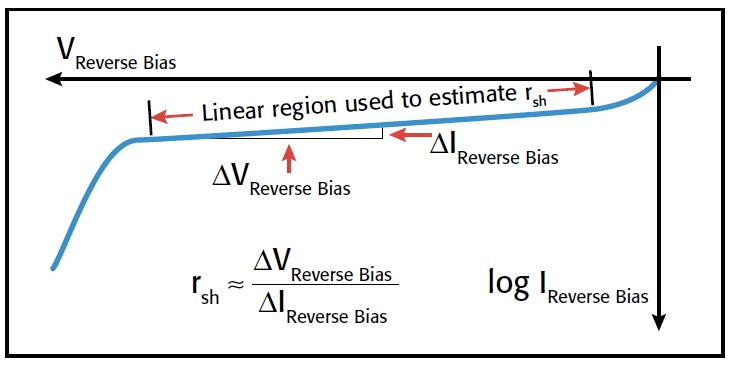


其它一些可以从PV电池直流I-V曲线中得出的数据表征了它的总体效率——将光能转换为电能的好快程度——可以用一些参数来定义,包括它的能量转换效率、最大功率性能和填充因数。最大功率点是最大电池电流和电压的乘积,这个位置的电池输出功率是最大的。
Other data that can be derived from the DC I-V plot of a PV cell characterize its overall efficiency—how well it transforms light into electricity—and can be defined by a number of parameters, including its energy conversion efficiency, its maximum power capability, and its fill factor. The maximum power point is the product of the maximum cell current and voltage where the power output of the cell is greatest.
填充因数[1](FF)是将PV电池的I-V特性与理想电池I-V特性进行比较的一种方式。理想情况下,它应该等于1,但在实际的PV电池中,它一般是小于1的。它实际上等于太阳能电池产生的最大功率(PMAX=IMAXVMAX)除以理想PV电池产生的功率。填充因数定义如下:
The fill factor (FF) is a way to compare a PV cell’s I?V characteristics to those of an ideal cell. Ideally, it would have a value of one, but in practical PV cells, it is always less than one. It is essentially the maximum power produced by a solar cell (PMAX=IMAXVMAX) divided by the power produced by an ideal PV cell. The fill factor is defined as:
FF = IMAXVMAX/(ISCVOC)
其中IMAX=最大输出功率时的电流,VMAX =最大输出功率时的电压,ISC =短路电流,VOC=开路电压。
where IMAX = the current at the maximum power output, VMAX = the voltage at the maximum power output, ISC = the short-circuit current, and VOC = the open-circuit voltage.
转换效率(h)是光伏电池最大输出功率(PMAX)与输入功率(PIN)的比值,即:
The conversion efficiency (h) is the ratio of the maximum power output (PMAX) to the power input (PIN) to the photovoltaic cell, or
h = PMAX/PIN
PV电池的I-V测量[2]可以在正偏(光照下)或反偏(黑暗中)两种情况下进行。正偏测量[3]是在PV电池照明受控的情况下进行的,光照能量表示电池的输入功率。用一段加载电压扫描电池,并测量电池产生的电流。一般情况下,加载到PV电池上的电压可以从0V到该电池的开路电压(VOC)进行扫描。在0V下,电流应该等于短路电流(ISC)。当电压为VOC时,电流应该为零。在如图1所示的模型中,ISC近似等于负载电流(IL)。
I?V measurements of a PV cell can be performed under forward-biased (in the light) or reverse-biased (in the dark) conditions. Forward bias measurements are performed under controlled illumination of the PV cell, with the light energy representing the input power to the cell. The cell is also swept through a range of applied voltages, and the resulting current from the cell is measured. Typically, the voltage applied to the PV cell might be swept from 0 V to the open-circuit voltage (VOC) for that cell. At 0 V, the current is expected to equal the value of the short-circuit current (ISC). When the voltage is set at VOC, the current is expected to be zero. In the model of Fig. 1, ISC is approximately equal to the load current (IL).
PV电池的串联电阻(rs)可以从至少两条在不同光强下测量的正偏I-V曲线中得出。光强的大小并不重要,因为它是电压变化与电流变化的比值,即曲线的斜率,就一切情况而论这才是有意义的。记住,曲线的斜率从开始到最后变化很大,我们所关心的数据出现在曲线的远正偏区域(far-forward region),这时曲线开始表现出线性特征。在这一点,电流变化的倒数与电压的函数关系就得出串联电阻的值:
The series resistance of a PV cell (rs) can be determined from at least two forward-biased I?V curves, measured at different light intensities. The magnitudes of the light intensities are not important, because it is the change in voltage with the change of current, or slope of the curve, that is meaningful in all cases. Bearing in mind that the slope of the curve changes dramatically from beginning to end, meaningful data can be found at the curve’s far-forward region, where the curve starts to take on linear characteristics. The inverse of the change in current as a function of voltage at this point gives the value for the series resistance:
rs = ΔV/ΔI
到目前为止本文所讨论的测量都是对暴露在发光输出功率下,即处于正偏条件下的PV电池进行的测量。但是PV器件的某些特征,例如分流电阻(rsh)和漏电流,恰恰是在PV电池避光即工作在反偏情况下得到的。对于这些I-V曲线,测量是在暗室中进行的,从起始电压为0V到PV电池开始击穿的点,测量输出电流并绘制其与加载电压的关系曲线。利用PV电池反偏I-V曲线的斜率也可以得到分流电阻的大小(如图5所示)。从该曲线的线性区,可以按下列公式计算出分流电阻:
The measurements discussed so far have been made with a PV cell exposed to light-generating output power, under forward-biased conditions. But some of the characteristics of a PV device, such as the shunt resistance (rsh) and the leakage current, are best found with the PV cell shielded from light and operating under reverse-biased conditions. For these I?V plots, measurements are made in a dark enclosure, from a starting voltage of 0 V to a point at which the PV cell begins to break down, with the output current measured and plotted as a function of the applied voltage. The shunt resistance can also be found by using the slope of a PV cell’s reverse bias I?V curve (Fig. 5). From the linear region of the curve, the shunt resistance can be found from
rsh = ΔV Reverse Bias/ΔI Reverse Bias

V反偏
用于估算rsh的线性区
ΔI反偏
ΔV反偏
 log I反偏
log I反偏
图5. 利用PV电池反偏I-V曲线的斜率可以得到PV电池的分流电阻。
Fig 5. A PV cell’s shunt resistance can be found by using the slope of a PV cell’s reverse bias I?V curve.
除了在没有任何光源的情况下进行这些测量之外,我们还应该对PV电池进行正确地屏蔽,并在测试配置中使用低噪声线缆。
In addition to making these measurements in the absence of any light sources, the PV cell should also be properly shielded and low-noise cables used in the test setup.
 /4
/4 
文章评论(0条评论)
登录后参与讨论